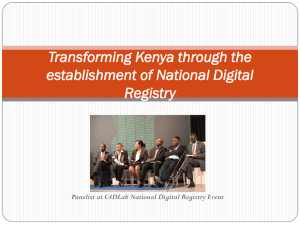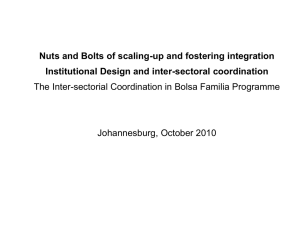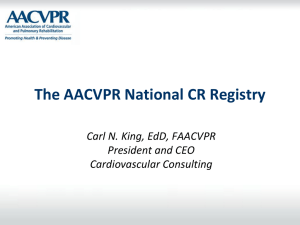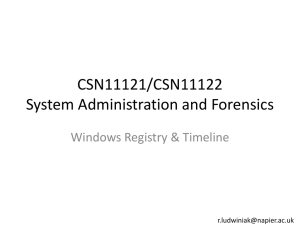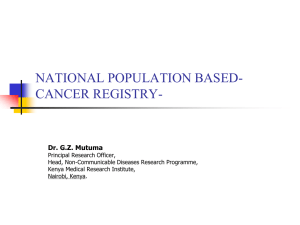inconectiv IP Interconnection Presentation - NANC
advertisement
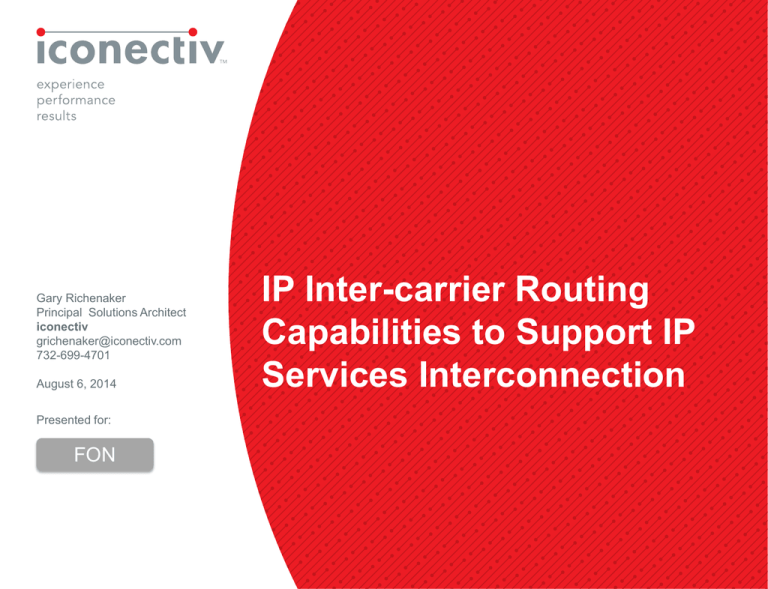
Gary Richenaker Principal Solutions Architect iconectiv grichenaker@iconectiv.com 732-699-4701 August 6, 2014 IP Inter-carrier Routing Capabilities to Support IP Services Interconnection Presented for: FON 1 Overview • In an all-IP network a Registry should provide the following essential functions • Policy • Allows trusted interconnect partners to share certain interconnect and routing information • Rules • Record efficiency • Peering with other Registries • No monopoly • A Registry should download to local cache • Not require ENUM cross network query per call 2 Background • Service providers have been transitioning their networks to IP for many years • The industry has been exploring ENUM based telephone number registries for a number of years • Although not deployed, these experiences will be useful as the industry begins to conceptualize the future IP 10-digit line level database. • A number of initiatives have recently been created to take the transition to all-IP networks to the next step 3 Key Market Drivers • The ongoing deployment of LTE, and the need to provide interoperability, roaming, and IP based interconnection for the new Voice over LTE (VoLTE) and High Definition (HD) voice services that are being launched worldwide • Although telecommunications users are identified in different ways for different services (e.g., telephone number, email address, internet domain name, location routing number), telephone numbers remain a ubiquitous mechanism for subscribers to find each other 4 Industry Developments • The GSM Association (GSMA) and the i3forum recently launched an IP interconnection initiative to drive the deployment of VoLTE and new high quality IP communication services through commercial pilots • In the US, the FCC is focusing on the sunset of the PSTN 5 Industry Developments • ATIS, the North American organizational partner for 3GPP, and the SIP Forum announced a joint task force in January 2014 to fully specify an IP communications Network-to-Network Interface (NNI) • The goal is to ensure all service interconnection between providers can occur at the IP level endto-end across wireless, wireline and cable providers 6 Challenge • Enable open access to IP services from a large number of providers to encourage innovation, competition, and a wide array of choice for consumers and businesses 7 Peering Registry Reference Architecture 8 Registry Capabilities • Policy • Allows trusted interconnect partners to share certain interconnect and routing information with each other • Rules • Provide the ability to aggregate the telephone numbers into a grouping, e.g., OCN, NPA-NXX, LRN, etc., or assign different attributes to a telephone number • Peering • Allows for multiple registry providers to synchronize with each other and offer the same authoritative data to their respective customers. 9 Policy • Allow for different Name Server records • Depending on the originating & terminating service provider combination, the registry could be configured with policy for source based resolution using a “Recipient Group” feature – For example, some authorized Service Providers of Record might input Name Server information for the same TN that in one case refers to the Tier 2 Name Server of a transit operator or Internetwork Packet Exchange (IPX) and in another case refers to their own terminating Tier 2 Name Server when they are peering or interconnecting directly with the originating service provider • The Service Provider that provisions the data will also likely define one or more selective lists of Data Recipients • Data is not given to unauthorized parties • Service providers determine the content of the Name Authority Pointer (NAPTR) records returned in response to ENUM queries 10 Rules • The number of records stored in an IP Interconnection Registry could be tens or hundreds of millions based on the need to assign different characteristics per TN • A single change can ripple through the data and touch a vast number of records • A rule that aggregates a number of TNs into a block such as NPA-NXX or NPA-NXX_X can dramatically reduce the number of records that need to be provisioned because it enables higher-level groupings that provide a compressed record set – For example, an NS or NAPTR record value could be assigned to each Operating Company Number (OCN) rather than to each telephone number or, to each unique Service Provider ID (SPID) and/or NPA/NXX or Location Routing Number (LRN) 11 Rules- cont’d • A single telephone number may be associated with several services, e.g., HD voice, Instant Messaging (IM), and IP telephony • The calling network needs to determine whether the called party has the requested service prior to setting up the call • A purpose-built registry can accommodate various service attributes at a TN level as well as at coarser levels based on rules established by the Service Provider • The use of rules allows the industry to provision services against higher levels of abstraction which optimize the number of records in the registry and especially in a local (cache) database 12 Mitigating the Impact of ENUM • Can we eliminate the cross-network queries and avoid the overhead of maintaining tier2 server farms? • NPAC can store the URIs and distribute locally through LSMS or XML downloads – However there is no policy in NPAC so all interconnecting parties will receive the same URI info – Vendor development required on SOA and LSMS tools • BIRDDS can store the NS or URIs and distribute locally via LERG file downloads – However there is also no policy in LERG so all interconnecting parties will receive the same URI info – Not currently storing routing data on full 10 digit TNs 13 Mitigating the Impact of ENUM- cont’d • Registry could optionally be used by service providers to capture and exchange NAPTR records instead of just NS records thereby combining Tier 2 functionality in the Tier 1 Registry • This could be optional according to terminating service provider discretion and would be transparent to the originating service provider • This would enable ENUM implementation without the complexity of cross network queries • Registry can download data to local cache 14 Registry Interworking • Examination of the often-heard statement that there can be “no more than one National ENUM Registry” because of synchronization issues • One obstacle to achieving synchronization is the quantity of data involved • The time taken to distribute a large number of changed records puts a lower bound on the time scale over which the Registries can be considered to be synchronized • However, it is often not necessary to distribute the changed records explicitly – Each registry includes a policy language and rule set that operates on the data’s metadata, unambiguously and completely describing the changes – Each registry uses the same policy language in conjunction with the established rules to describe changes sent and to interpret changes received 15 Registry Interworking – cont’d • The FTP-based component relies on a file naming convention and an agreed-upon directory structure which is consistent over all participants • The file names contain an identifier for the intended recipient and a timestamp • The files are named either ALL or INCR – The INCR (Incremental) files contain only changes to data made during the last hour, whereas – the ALL files are a dump of the entire database, written every 24 hours • The Web Services component provides near-real-time response • Each registry commits to exposing changes on the Web Services interface within a matter of seconds, and other Registries poll the interface as often as desired, typically every 15 seconds 16 Registry Interworking – cont’d • As the migration to a service rich IP environment occurs, multiple ENUM registries can co-exist and it is important to enable peering capability • As an example, this overall architecture already exists within the TV White Spaces industry • The Whitespaces Database Administrators (WSDBA) group has defined an architecture and an Interoperability Specification • (http://apps. fcc.gov/ecfs/document/view?id=7520963472) 17 Summary • As more and more telecommunications services are designed for, or migrate to, IP an authoritative means for identifying telecommunications users and services reachable via IP will become a prerequisite to operate at scale • For example, VoIP, VoLTE, high definition voice, messaging, and M2M communications • A standards-based mechanism will be needed for mapping a telephone number into IP addresses designating servicespecific interconnection points • A trusted, centrally-managed IP interconnection registry for inter-carrier routing of IP services can be enabled and should provide three essential functions; • Policy during the provisioning process, • Rules based on routing granularity, and • The ability to support multiple competing IP interconnection registries 18 Q&A Thank you! 19




